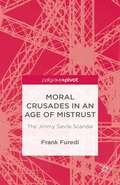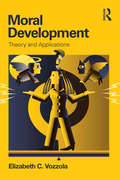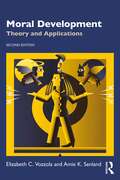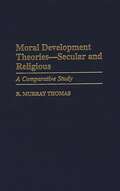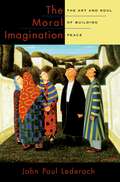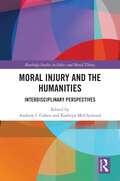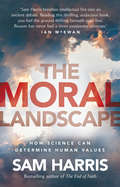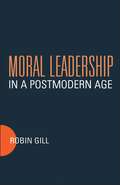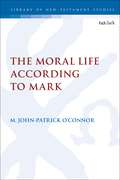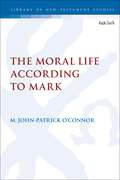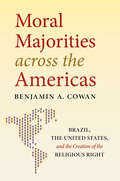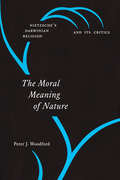- Table View
- List View
Moral Crusades in an Age of Mistrust: The Jimmy Savile Scandal
by F. FurediThe epidemic of scandals unleashed by the Savile Scandal highlights the precarious status of relations of trust. The rapid escalation of this crisis offers insights into the relationship between anxieties about childhood and the wider moral order. This book explains why western society has become so uncomfortable with the exercise of authority.
The Moral Culture of the Scottish Enlightenment: 1690–1805 (The Lewis Walpole Series in Eighteenth-Century Culture and History)
by Thomas AhnertIn the Enlightenment it was often argued that moral conduct, rather than adherence to theological doctrine, was the true measure of religious belief. Thomas Ahnert argues that this “enlightened” emphasis on conduct in religion relied less on arguments from reason alone than has been believed. In fact, Scottish Enlightenment champions advocated a practical program of “moral culture,” in which revealed religion was of central importance. Ahnert traces this to theological controversies going back as far as the Reformation concerning the conditions of salvation. His findings present a new point of departure for all scholars interested in the intersection of religion and Enlightenment.
Moral Development: Theory and Applications
by Elizabeth C. VozzolaA CHOICE Outstanding Academic Title 2014! This class-tested text provides a comprehensive overview of the classical and current theories of moral development and applications of these theories in various counseling and educational settings. Lively and accessible, this text engages students through numerous examples and boxes that highlight applications of moral development concepts in today’s media and/or interviews from some of today’s leading theorists or practitioners. Dilemma of the Day boxes help readers apply theory to real world situations. Each chapter concludes with discussion questions and further resources. Summary tables of theory strengths and weaknesses (Part 1) and tables that connect applications to their theoretical roots are provided in Part 2. Other highlights include: Provides an excellent resource for courses addressing the CACREP program objectives for Human Growth and Development. Emphasis on application helps readers make the connection between theory and moral issues of our time. Examines changes across time and experience in how people understand right and wrong and individual differences in moral judgments, emotions, and actions. Demonstrates how theory is used by today‘s helping professionals (Part 1). Integrates issues of gender and ethnicity throughout to prepare readers for practicing in a global culture. Chapter on global perspectives (ch. 6) reviews theories on the cultural aspects of morality including examples from China, Islam, Latin America, and Africa. Reviews the latest research methods techniques used in the field. Integrates classic work with contemporary guidelines for assessment and treatment. Highlights research on the moral and empathic development of antisocial youth, psychopaths, and individuals diagnosed on the Autism Spectrum. Each chapter in Part 1 provides a comprehensive overview of the theory under review, its strengths and challenges, and examples of how the theory applies to helping professionals. The theories covered include those by Freud, Piaget, Kohlberg, Rest, Gilligan, Nodding, Bandura, Turiel, Nucci, Haidt, and Shweder. Part 1 concludes with a summary of the key points and the strengths and weaknesses of each of the theories reviewed. Part 2 highlights promising applications of moral development theory in education and counseling. These include coverage of character education programs based on sound developmental theory and examples of how drawing on a deep grounding in moral development theory can help future counselors better evaluate their clients’ cognitive, emotional and behavioral challenges. The text explores specific approaches to helping clients with a variety of dysfunctional or developmental behavior problems like conduct disorder and psychopathy. Ideal as a text for advanced undergraduate and/or graduate courses on moral development or moral psychology or as a supplement in courses on human and/or child and/or social and personality development taught in psychology, counseling, education, human development, family studies, social work, and religion, this book’s applied approach also appeals to mental health and school counselors.
Moral Development: Theory and Applications
by Elizabeth C. VozzolaA CHOICE Outstanding Academic Title 2014! This class-tested text provides a comprehensive overview of the classical and current theories of moral development and applications of these theories in various counseling and educational settings. Lively and accessible, this text engages students through numerous examples and boxes that highlight applications of moral development concepts in today’s media and/or interviews from some of today’s leading theorists or practitioners. Dilemma of the Day boxes help readers apply theory to real world situations. Each chapter concludes with discussion questions and further resources. Summary tables of theory strengths and weaknesses (Part 1) and tables that connect applications to their theoretical roots are provided in Part 2. Other highlights include: Provides an excellent resource for courses addressing the CACREP program objectives for Human Growth and Development. Emphasis on application helps readers make the connection between theory and moral issues of our time. Examines changes across time and experience in how people understand right and wrong and individual differences in moral judgments, emotions, and actions. Demonstrates how theory is used by today‘s helping professionals (Part 1). Integrates issues of gender and ethnicity throughout to prepare readers for practicing in a global culture. Chapter on global perspectives (ch. 6) reviews theories on the cultural aspects of morality including examples from China, Islam, Latin America, and Africa. Reviews the latest research methods techniques used in the field. Integrates classic work with contemporary guidelines for assessment and treatment. Highlights research on the moral and empathic development of antisocial youth, psychopaths, and individuals diagnosed on the Autism Spectrum. Each chapter in Part 1 provides a comprehensive overview of the theory under review, its strengths and challenges, and examples of how the theory applies to helping professionals. The theories covered include those by Freud, Piaget, Kohlberg, Rest, Gilligan, Nodding, Bandura, Turiel, Nucci, Haidt, and Shweder. Part 1 concludes with a summary of the key points and the strengths and weaknesses of each of the theories reviewed. Part 2 highlights promising applications of moral development theory in education and counseling. These include coverage of character education programs based on sound developmental theory and examples of how drawing on a deep grounding in moral development theory can help future counselors better evaluate their clients’ cognitive, emotional and behavioral challenges. The text explores specific approaches to helping clients with a variety of dysfunctional or developmental behavior problems like conduct disorder and psychopathy. Ideal as a text for advanced undergraduate and/or graduate courses on moral development or moral psychology or as a supplement in courses on human and/or child and/or social and personality development taught in psychology, counseling, education, human development, family studies, social work, and religion, this book’s applied approach also appeals to mental health and school counselors.
Moral Development: Theory and Applications
by Elizabeth C. Vozzola Amie K. SenlandMoral Development offers a comprehensive overview of classic and current theories of moral development and applications of these theories in various counseling and educational settings. It examines changes across time and experience in how people understand right and wrong, and individual differences in moral judgements, emotions, and actions. Elizabeth C. Vozzola and Amie K. Senland review the latest research in the field and integrate classic work with contemporary perspectives on assessment and treatment. Part 1 provides an understanding of a range of theories, explaining their strengths and challenges, and offering examples of how these theories apply to helping professionals. It covers Freud, Piaget, Kohlberg, Rest, Gilligan, Nodding, Bandura, Turiel, Nucci, Narvaez, Haidt, and Shweder. Part 2 highlights promising applications of moral development theory in education and counseling. Fully updated with new chapters on faith development and moral and prosocial development in infancy and early childhood, the text explores specific approaches to helping clients with a variety of clinical or developmental challenges and provides an excellent resource for courses addressing the CACREP program objectives for Human Growth and Development. It also integrates issues of gender, ethnicity, and culture throughout to prepare readers for practicing in a global culture and presents a new perspective: the cultural developmental approach. Illustrated throughout with examples that highlight applications of moral development concepts in today’s media, it also includes interviews from some of today’s leading theorists and practitioners. Ideal as a text for advanced courses on moral development and moral psychology, as well as courses on human, child, social and personality development taught in psychology, counseling, education, human development, family studies, social work, and religion. Its applied approach also appeals to mental health and school counselors.
Moral Development: Theory and Applications
by Elizabeth C. Vozzola Amie K. SenlandMoral Development offers a comprehensive overview of classic and current theories of moral development and applications of these theories in various counseling and educational settings. It examines changes across time and experience in how people understand right and wrong, and individual differences in moral judgements, emotions, and actions. Elizabeth C. Vozzola and Amie K. Senland review the latest research in the field and integrate classic work with contemporary perspectives on assessment and treatment. Part 1 provides an understanding of a range of theories, explaining their strengths and challenges, and offering examples of how these theories apply to helping professionals. It covers Freud, Piaget, Kohlberg, Rest, Gilligan, Nodding, Bandura, Turiel, Nucci, Narvaez, Haidt, and Shweder. Part 2 highlights promising applications of moral development theory in education and counseling. Fully updated with new chapters on faith development and moral and prosocial development in infancy and early childhood, the text explores specific approaches to helping clients with a variety of clinical or developmental challenges and provides an excellent resource for courses addressing the CACREP program objectives for Human Growth and Development. It also integrates issues of gender, ethnicity, and culture throughout to prepare readers for practicing in a global culture and presents a new perspective: the cultural developmental approach. Illustrated throughout with examples that highlight applications of moral development concepts in today’s media, it also includes interviews from some of today’s leading theorists and practitioners. Ideal as a text for advanced courses on moral development and moral psychology, as well as courses on human, child, social and personality development taught in psychology, counseling, education, human development, family studies, social work, and religion. Its applied approach also appeals to mental health and school counselors.
Moral Development Theories -- Secular and Religious: A Comparative Study (Contributions to the Study of Education)
by R. Murray ThomasMoral Development Theories—Secular and Religious introduces readers to 13 secular models and 13d religious theories in a wide-ranging comparative study of the roots of moral development. The secular models include attribution theory, cognitive-structural views, social-learning and social-cognition approaches, Freud's psychoanalysis (plus Erikson and Fromm), Marxist beliefs, a composite theory, Hoffman's conception of empathy, Anderson's information-integration view, Gilligan's gender distinction, Sutherland and Cressey's explanation of delinquency, and Lovinger on ego development. Religious theories represent the Judaic-Christian-Islamic line, Hinduism and derivatives (Buddhism, Jainism, Sikhism), Confucianism, Shinto, and four minor theories drawn from the belief systems of the Navajo, Zulus, Vodou adherents, and Okinawans.The description of each theory is designed to answer a common set of questions introduced in Chapter 1. The closing section of each chapter evaluates that chapter's theories in terms of a series of assessment standards described in Chapter 2. The book's final chapter inspects all of the theories from the viewpoint of five desires that people often hold in relation to their conceptions of moral development. The desires are: (a) for immanent justice; (b) to understand the causes of the consequences that result from people's behavior in moral situations; (c) to become immortal; (d) to enjoy a happy life, and (e) to understand the moral-development process in order to help others who need moral guidance.
The Moral Dynamics of Economic Life: An Extension and Critique of Caritas in Veritate
by Daniel K. FinnCaritas in veritate (Charity in Truth) is the ''social'' encyclical of Pope Benedict XVI, one of many papal encyclicals over the last 120 years that address economic life. This volume, based on discussions at a symposium co-sponsored by the Institute for Advanced Catholic Studies and the Pontifical Council for Justice and Peace, analyzes the situation of the Church and the theological basis for Benedict's thinking about the person, community, and the globalized economy. The Moral Dynamics of Economic Life engages Benedict's analysis of ''relation,'' the characteristics of contemporary social and economic relationships and the implications of a relational, Trinitarian God for daily human life. Crucial here is the Pope's notion of ''reciprocity,'' an economic relationship characterized by help freely given, but which forms an expectation that the recipient will ''reciprocate,'' either to the donor or, often, to someone else. This ''logic of gift,'' Benedict argues, should influence daily economic life, especially within what he calls ''hybrid'' firms, which make a profit and invest a share of that profit in service to needs outside the firm. Similarly, development - whether of an individual or of a nation - must be integral, neither simply economic nor personal nor psychological nor spiritual, but a comprehensive development that engages all dimensions of a flourishing human life. The essays, written by social scientists, theologians, policy analysts and others, engage, extend, and critique Benedict's views on these issues, as well as his call for deeper dialogue and a morally based transformation of social and economic structures.
The Moral Geographies of Children, Young People and Food: Beyond Jamie's School Dinners
by J. Pike P. KellyThis book takes Jamie Oliver's campaign for better school meals as a starting point for thinking about morally charged concerns relating to young people's nutrition, health and well-being, parenting, and public health 'crises' such as obesity. The authors show how these debates are always about the moral project of the self.
The Moral Heart of Public Service
by William Hague Rowan Williams John Hall Andrew Tremlett Peter Hennessy Stephen Lamport Vernon White Mary McAleeseOne year after Brexit, a stellar cast of eminent contributors from politics, public service and religion explore why now more than ever, public servants must consider and reassess how to keep moral courage in public life alive.
The Moral Imagination: The Art and Soul of Building Peace
by John Paul LederachJohn Paul Lederach's work in the field of conciliation and mediation is internationally recognized. As founding Director of the Conflict Transformation Program and Institute of Peacebuilding at Eastern Mennonite University, he has provided consultation and direct mediation in a range of situations from the Miskito/Sandinista conflict in Nicaragua to Somalia, Northern Ireland, the Basque Country, and the Philippines. His influential 1997 book Building Peace has become a classic in the discipline. This new book represents his thinking and learning over the past several years. He explores the evolution of his understanding of peacebuilding by reflecting on his own experiences in the field. Peacebuilding, in his view, is both a learned skill and an art. Finding this art, he says, requires a worldview shift. Conflict professionals must envision their work as a creative act - an exercise of what Lederach terms the "moral imagination."
The Moral Imagination: The Art and Soul of Building Peace
by John Paul LederachJohn Paul Lederach's work in the field of conciliation and mediation is internationally recognized. As founding Director of the Conflict Transformation Program and Institute of Peacebuilding at Eastern Mennonite University, he has provided consultation and direct mediation in a range of situations from the Miskito/Sandinista conflict in Nicaragua to Somalia, Northern Ireland, the Basque Country, and the Philippines. His influential 1997 book Building Peace has become a classic in the discipline. This new book represents his thinking and learning over the past several years. He explores the evolution of his understanding of peacebuilding by reflecting on his own experiences in the field. Peacebuilding, in his view, is both a learned skill and an art. Finding this art, he says, requires a worldview shift. Conflict professionals must envision their work as a creative act - an exercise of what Lederach terms the "moral imagination."
Moral Injury After Abortion: Exploring the Psychospiritual Impact on Catholic Women
by Tara C. Carleton Jill L. SnodgrassMoral Injury After Abortion delves deeply into the psychospiritual responses that some women experience when an abortive act conflicts with their moral beliefs and values. The book is grounded in a qualitative, phenomenological study that examined the lived experiences of thirty Christian women after abortion. The study participants’ voices are woven throughout the book in a way that offers the reader a narrative understanding of their experiences and a thick description of the psychospiritual impact of moral injury after abortion. The book provides mental health scholars and professionals with strategies for assessing for moral injury experiences among women post-abortion as well as a guide for addressing the spiritual and psychological impact of post-abortive moral injury.
Moral Injury After Abortion: Exploring the Psychospiritual Impact on Catholic Women
by Tara C. Carleton Jill L. SnodgrassMoral Injury After Abortion delves deeply into the psychospiritual responses that some women experience when an abortive act conflicts with their moral beliefs and values. The book is grounded in a qualitative, phenomenological study that examined the lived experiences of thirty Christian women after abortion. The study participants’ voices are woven throughout the book in a way that offers the reader a narrative understanding of their experiences and a thick description of the psychospiritual impact of moral injury after abortion. The book provides mental health scholars and professionals with strategies for assessing for moral injury experiences among women post-abortion as well as a guide for addressing the spiritual and psychological impact of post-abortive moral injury.
Moral Injury and the Humanities: Interdisciplinary Perspectives (Routledge Studies in Ethics and Moral Theory)
by Andrew I. CohenThis book brings together leading interdisciplinary scholars to broaden and deepen the conversation about moral injury. In the original chapters, the contributors present new research to show how the humanities are crucial for understanding the expressions, meaning, and significance of moral injury. Moral injury is the disorientation we suffer when we are complicit in some moral transgression. Most existing works address moral injury from a clinical or neuroscientific perspective. The chapters in this volume show how the humanities are crucial for understanding the meaning and significance of moral injury as well as suggesting how to grapple with its lived challenges. The chapters address the conceptual, sociological, historical, and ritualistic dimensions of moral injury across three thematic sections. Section 1 explores how tools of the humanities provide new lenses for understanding conceptual and genealogical themes about moral injury. Section 2 highlights the experiences of moral injury in combat soldiers, law enforcement, and noncombatants such as photojournalists. These chapters examine the power and limits to theorizing moral phenomena by appeals to lived experience. Section 3 considers how humanistic inquiry illuminates important dimensions of the aftermath of moral injury beyond the scope of clinical research. These chapters consider how ritual, relationship repair, and atonement might shape the ways people navigate moral injury and consider how such responses shape our understanding of what we owe to one another. Moral Injury and the Humanities: Interdisciplinary Perspectives is an essential resource for researchers and advanced students in philosophy, religious studies, literature, journalism, and the arts who are interested in moral injury.
Moral Injury and the Humanities: Interdisciplinary Perspectives (Routledge Studies in Ethics and Moral Theory)
This book brings together leading interdisciplinary scholars to broaden and deepen the conversation about moral injury. In the original chapters, the contributors present new research to show how the humanities are crucial for understanding the expressions, meaning, and significance of moral injury. Moral injury is the disorientation we suffer when we are complicit in some moral transgression. Most existing works address moral injury from a clinical or neuroscientific perspective. The chapters in this volume show how the humanities are crucial for understanding the meaning and significance of moral injury as well as suggesting how to grapple with its lived challenges. The chapters address the conceptual, sociological, historical, and ritualistic dimensions of moral injury across three thematic sections. Section 1 explores how tools of the humanities provide new lenses for understanding conceptual and genealogical themes about moral injury. Section 2 highlights the experiences of moral injury in combat soldiers, law enforcement, and noncombatants such as photojournalists. These chapters examine the power and limits to theorizing moral phenomena by appeals to lived experience. Section 3 considers how humanistic inquiry illuminates important dimensions of the aftermath of moral injury beyond the scope of clinical research. These chapters consider how ritual, relationship repair, and atonement might shape the ways people navigate moral injury and consider how such responses shape our understanding of what we owe to one another. Moral Injury and the Humanities: Interdisciplinary Perspectives is an essential resource for researchers and advanced students in philosophy, religious studies, literature, journalism, and the arts who are interested in moral injury.
Moral Injury Reconciliation: A Practitioner's Guide for Treating Moral Injury, PTSD, Grief, and Military Sexual Trauma through Spiritual Formation Strategies
by Lewis Jeffery LeeAimed at Veterans suffering from moral injury and PTSD, the author has created a 3-phased spiritual care treatment based on reconciling past trauma, creating a focused present and anticipating a hopeful future. It blends spiritual awareness exercises, EBT elements, psychoeducation and self-care techniques.
The Moral Landscape: How Science Can Determine Human Values
by Sam HarrisSam Harris's first book, The End of Faith, ignited a worldwide debate about the validity of religion. In the aftermath, Harris discovered that most people - from religious fundamentalists to nonbelieving scientists - agree on one point: science has nothing to say on the subject of human values. Indeed, our failure to address questions of meaning and morality through science has now become the primary justification for religious faith.In this highly controversial book, Sam Harris seeks to link morality to the rest of human knowledge. Defining morality in terms of human and animal well-being, Harris argues that science can do more than tell how we are; it can, in principle, tell us how we ought to be. In his view, moral relativism is simply false - and comes at an increasing cost to humanity. And the intrusions of religion into the sphere of human values can be finally repelled: for just as there is no such thing as Christian physics or Muslim algebra, there can be no Christian or Muslim morality. Using his expertise in philosophy and neuroscience, along with his experience on the front lines of our 'culture wars', Harris delivers a game-changing book about the future of science and about the real basis of human cooperation.
Moral Leadership in a Postmodern Age
by Robin GillRobin Gill examines the issues that connect faith and moral leadership in an increasingly fragmented and relativistic world.
The Moral Life According to Mark (The Library of New Testament Studies)
by M. John-Patrick O’ConnorM. John-Patrick O'Connor proposes that - in contrast to recent contemporary scholarship that rarely focuses on the ethical implications of discipleship and Christology - Mark's Gospel, as our earliest life of Jesus, presents a theological description of the moral life.Arguing for Mark's ethical validity in comparison to Matthew and Luke, O'Connor begins with an analysis of the moral environment of ancient biographies, exploring what types of Jewish and Greco-Romanic conceptions of morality found their way into Hellenistic biographies. Turning to the Gospel's own examples of morality, O'Connor examines moral accountability according to Mark, including moral reasoning, the nature of a world in conflict, and accountability in both God's family and to God's authority. He then turns to images of the accountable self, including an analysis of virtues and virtuous practices within the Gospel. O'Connor concludes with the personification of evil, human responsibility, punitive consequences, and evil's role in Mark's moral landscape.
The Moral Life According to Mark (The Library of New Testament Studies)
by M. John-Patrick O’ConnorM. John-Patrick O'Connor proposes that - in contrast to recent contemporary scholarship that rarely focuses on the ethical implications of discipleship and Christology - Mark's Gospel, as our earliest life of Jesus, presents a theological description of the moral life.Arguing for Mark's ethical validity in comparison to Matthew and Luke, O'Connor begins with an analysis of the moral environment of ancient biographies, exploring what types of Jewish and Greco-Romanic conceptions of morality found their way into Hellenistic biographies. Turning to the Gospel's own examples of morality, O'Connor examines moral accountability according to Mark, including moral reasoning, the nature of a world in conflict, and accountability in both God's family and to God's authority. He then turns to images of the accountable self, including an analysis of virtues and virtuous practices within the Gospel. O'Connor concludes with the personification of evil, human responsibility, punitive consequences, and evil's role in Mark's moral landscape.
The Moral Life: Essays in Honour of John Cottingham
by N. Athanassoulis S. ViceA collection of essays by leading philosophers on the work of John Cottingham, focussing on his work in moral philosophy, discussing themes from his contributions to the debate on partiality and impartiality, the role of the emotions in the good life and the meaning of the worthwhile life. Including a 'replies' chapter by John Cottingham.
Moral Majorities across the Americas: Brazil, the United States, and the Creation of the Religious Right
by Benjamin A. CowanThis new history of the Christian right does not stop at national or religious boundaries. Benjamin A. Cowan chronicles the advent of a hemispheric religious movement whose current power and influence make headlines and generate no small amount of shock in Brazil and the United States. These two countries, Cowan argues, played host to the principal activists and institutions who collaboratively fashioned the ascendant religious conservatism of the late twentieth century. Cowan not only unearths the deep historical connections between Brazilian and U.S. religious conservatives but also proves just how essential Brazilian thinkers, activists, and institutions were to engendering right-wing political power in the Americas.Cowan shows that both Protestant and Catholic religious warriors began to commune in the 1930s around a passionate aversion to mainstream ecumenicalism and moderate political ideas. Brazilian intellectuals, politicians, religious leaders, and captains of industry worked with partners at home and in the United States to build a united right. Together, activists engaged in a series of reactionary theological discussions. Their transnational, transdenominational platform fostered a sense of common cause and allowed them to develop a series of strategies that pushed once marginal ideas to the center of public discourse, reshaped religious demographics, and effected a rightward shift in politics across two continents.
The Moral Meaning of Nature: Nietzsche’s Darwinian Religion and Its Critics
by Peter J. WoodfordWhat, if anything, does biological evolution tell us about the nature of religion, ethical values, or even the meaning and purpose of life? The Moral Meaning of Nature sheds new light on these enduring questions by examining the significance of an earlier—and unjustly neglected—discussion of Darwin in late nineteenth-century Germany. We start with Friedrich Nietzsche, whose writings staged one of the first confrontations with the Christian tradition using the resources of Darwinian thought. The lebensphilosophie, or “life-philosophy,” that arose from his engagement with evolutionary ideas drew responses from other influential thinkers, including Franz Overbeck, Georg Simmel, and Heinrich Rickert. These critics all offered cogent challenges to Nietzsche’s appropriation of the newly transforming biological sciences, his negotiation between science and religion, and his interpretation of the implications of Darwinian thought. They also each proposed alternative ways of making sense of Nietzsche’s unique question concerning the meaning of biological evolution “for life.” At the heart of the discussion were debates about the relation of facts and values, the place of divine purpose in the understanding of nonhuman and human agency, the concept of life, and the question of whether the sciences could offer resources to satisfy the human urge to discover sources of value in biological processes. The Moral Meaning of Nature focuses on the historical background of these questions, exposing the complex ways in which they recur in contemporary philosophical debate.
The Moral Meaning of Nature: Nietzsche’s Darwinian Religion and Its Critics
by Peter J. WoodfordWhat, if anything, does biological evolution tell us about the nature of religion, ethical values, or even the meaning and purpose of life? The Moral Meaning of Nature sheds new light on these enduring questions by examining the significance of an earlier—and unjustly neglected—discussion of Darwin in late nineteenth-century Germany. We start with Friedrich Nietzsche, whose writings staged one of the first confrontations with the Christian tradition using the resources of Darwinian thought. The lebensphilosophie, or “life-philosophy,” that arose from his engagement with evolutionary ideas drew responses from other influential thinkers, including Franz Overbeck, Georg Simmel, and Heinrich Rickert. These critics all offered cogent challenges to Nietzsche’s appropriation of the newly transforming biological sciences, his negotiation between science and religion, and his interpretation of the implications of Darwinian thought. They also each proposed alternative ways of making sense of Nietzsche’s unique question concerning the meaning of biological evolution “for life.” At the heart of the discussion were debates about the relation of facts and values, the place of divine purpose in the understanding of nonhuman and human agency, the concept of life, and the question of whether the sciences could offer resources to satisfy the human urge to discover sources of value in biological processes. The Moral Meaning of Nature focuses on the historical background of these questions, exposing the complex ways in which they recur in contemporary philosophical debate.
